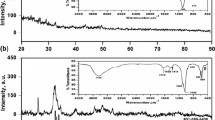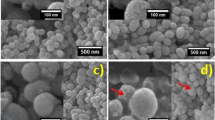Abstract
A novel mesoporous bioactive glass (MBG) of composition 64SiO2–26CaO–10P2O5 (mol %) was prepared by hydrothermal method using H3PO4 as a precursor for P2O5. The effect of use of organic triethylphosphate (TEP) and inorganic H3PO4 in MBG synthesis on glass transition temperature (T g), crystallinity, morphology and bioactivity of MBGs was studied. Phase purity determination and structural analysis were done using powder X-ray diffraction (XRD) and Fourier transform infrared (FTIR) spectroscopy, respectively. XRD revealed that MBG prepared from H3PO4 (MBG-H3PO4) when sintered at 700 °C was partially glassy/amorphous in nature and contained a mixture of crystalline apatite, wollastonite, calcium phosphate and calcium silicate phases. Calcined MBG prepared from TEP (MBG-TEP) contained only wollastonite and calcium silicate phases. Particle size and surface area determined by BET surface area analysis showed higher surface area (310 m2 g−1) for MBG-H3PO4 as compared to MBG-TEP (86 m2 g−1). It also had a smaller particle size (20 nm) and 70 % higher pore volume (0.88 cm3 g−1) for MBG-H3PO4 as compared to MBG-TEP (60 nm particle size and 0.23 cm3 g−1 pore volume). Thermal studies showed that use of H3PO4 decreases T g and increased ΔT (difference between T g and crystallization initiation temperature Tco). Low T g and high ΔT also enhanced bioactivity of MBGs. Bioactivity was determined by immersion in a simulated body fluid for varying time intervals for a maximum period of 14 days. It revealed enhanced bioactivity, as evident by the formation of apatite layer on the surface, for MBG-H3PO4 as compared to MBG-TEP. Scanning electron microscopy and FTIR spectroscopy also supported this observation. Antibacterial studies with Escherichia Coli bacteria, MBG-H3PO4 showed better antibacterial behaviour than MBG-TEP.









Similar content being viewed by others
References
Wu C, Chang J (2012) Mesoporous bioactive glasses: structure characteristics, drug/growth factor delivery and bone regeneration application. Interface Focus 2(3):292–306
Hench LL, Wheeler DL, Greenspan DC (1998) Molecular control of bioactivity in sol–gel glasses. J Sol Gel Sci Technol 13(1–3):245–250
Balamurugan A, Balossier G, Kannan S, Michel J, Rebelo AH, Ferreira JM (2007) Development and in vitro characterization of sol–gel derived CaO–P2O5–SiO2–ZnO bioglass. Acta Biomater 3(2):255–262
Rehman I, Hench LL, Bonfield W, Smith R (1994) Analysis of surface layers on bioactive glasses. Biomaterials 15(10):865–870. doi:10.1016/0142-9612(94)90044-2
Rehman I, Knowles JC, Bonfield W (1998) Analysis of in vitro reaction layers formed on Bioglass® using thin-film X-ray diffraction and ATR-FTIR microspectroscopy. J Biomed Mater Res 41(1):162–166. doi:10.1002/(sici)1097-4636(199807)41:1<162:aid-jbm19>3.0.co;2-p
Felício-Fernandes G, Laranjeira M (2000) Calcium phosphate biomaterials from marine algae. Hydrothermal synthesis and characterisation. Quim Nova 23(4):441–446
Xia W, Chang J (2008) Preparation, in vitro bioactivity and drug release property of well-ordered mesoporous 58S bioactive glass. J Non Cryst Solids 354(12):1338–1341
Mozafari M, Moztarzadeh F, Rabiee M, Azami M, Maleknia S, Tahriri M, Moztarzadeh Z, Nezafati N (2010) Development of macroporous nanocomposite scaffolds of gelatin/bioactive glass prepared through layer solvent casting combined with lamination technique for bone tissue engineering. Ceram Int 36(8):2431–2439. doi:10.1016/j.ceramint.2010.07.010
Jones JR (2013) Review of bioactive glass: from Hench to hybrids. Acta Biomater 9(1):4457–4486. doi:10.1016/j.actbio.2012.08.023
Sepulveda P, Jones JR, Hench LL (2001) Characterization of melt-derived 45S5 and sol–gel-derived 58S bioactive glasses. J Biomed Mater Res 58(6):734–740
Siqueira RL, Peitl O, Zanotto ED (2011) Gel-derived SiO2–CaO–Na2O–P2O5 bioactive powders: synthesis and in vitro bioactivity. Mater Sci Eng C 31(5):983–991. doi:10.1016/j.msec.2011.02.018
Yu B, Turdean-Ionescu CA, Martin RA, Newport RJ, Hanna JV, Smith ME, Jones JR (2012) Effect of calcium source on structure and properties of sol–gel derived bioactive glasses. Langmuir 28(50):17465–17476. doi:10.1021/la303768b
Kokubo T, Takadama H (2006) How useful is SBF in predicting in vivo bone bioactivity? Biomaterials 27(15):2907–2915. doi:10.1016/j.biomaterials.2006.01.017
H-s Yun, S-e Kim, Y-t Hyun (2008) Preparation of 3D cubic ordered mesoporous bioactive glasses. Solid State Sci 10(8):1083–1092. doi:10.1016/j.solidstatesciences.2007.11.037
Jones JR, Ehrenfried LM, Hench LL (2006) Optimising bioactive glass scaffolds for bone tissue engineering. Biomaterials 27(7):964–973
Aguiar H, Serra J, González P, León B (2009) Structural study of sol–gel silicate glasses by IR and Raman spectroscopies. J Non Cryst Solids 355(8):475–480. doi:10.1016/j.jnoncrysol.2009.01.010
Jung HY, Gupta RK, Oh EO, Kim YH, Whang CM (2005) Vibrational spectroscopic studies of sol–gel derived physical and chemical bonded ORMOSILs. J Non Cryst Solids 351(5):372–379. doi:10.1016/j.jnoncrysol.2005.01.004
Aina V, Malavasi G, Fiorio Pla A, Munaron L, Morterra C (2009) Zinc-containing bioactive glasses: surface reactivity and behaviour towards endothelial cells. Acta Biomater 5(4):1211–1222. doi:10.1016/j.actbio.2008.10.020
El-Kady AM, Ali AF (2012) Fabrication and characterization of ZnO modified bioactive glass nanoparticles. Ceram Int 38(2):1195–1204. doi:10.1016/j.ceramint.2011.07.069
Vaid C, Murugavel S, Das C, Asokan S (2014) Mesoporous bioactive glass and glass–ceramics: influence of the local structure on in vitro bioactivity. Microporous Mesoporous Mater 186:46–56. doi:10.1016/j.micromeso.2013.11.027
Xia W, Chang J (2006) Well-ordered mesoporous bioactive glasses (MBG): a promising bioactive drug delivery system. J Control Release 110(3):522–530. doi:10.1016/j.jconrel.2005.11.002
Carta D, Knowles JC, Smith ME, Newport RJ (2007) Synthesis and structural characterization of P2O5–CaO–Na2O sol–gel materials. J Non Cryst Solids 353(11–12):1141–1149. doi:10.1016/j.jnoncrysol.2006.12.093
Koutsopoulos S (2002) Synthesis and characterization of hydroxyapatite crystals: a review study on the analytical methods. J Biomed Mater Res 62(4):600–612. doi:10.1002/jbm.10280
García A, Cicuéndez M, Izquierdo-Barba I, Arcos D, Vallet-Regí M (2009) Essential role of calcium phosphate heterogeneities in 2D-hexagonal and 3D-cubic SiO2–CaO–P2O5 mesoporous bioactive glasses. Chem Mater 21(22):5474–5484. doi:10.1021/cm9022776
Yan X, Deng H, Huang X, Lu G, Qiao S, Zhao D, Yu C (2005) Mesoporous bioactive glasses. I. Synthesis and structural characterization. J Non Cryst Solids 351(40):3209–3217
Lei B, Chen X, Wang Y, Zhao N, Du C, Fang L (2010) Influence of sintering temperature on pore structure and apatite formation of a sol–gel-derived bioactive glass. J Am Ceram Soc 93(1):32–35
Ma J, Chen C, Wang D, Meng X, Shi J (2010) Influence of the sintering temperature on the structural feature and bioactivity of sol–gel derived SiO2–CaO–P2O5 bioglass. Ceram Int 36(6):1911–1916
Peitl Filho O, Latorre GP (1996) Effect of crystallization on apatite-layer formation of bioactive glass 45 %. J Biomed Mater Res 30:509–514
Huang J, Silvio LD, Wang M, Rehman I, Ohtsuki C, Bonfield W (1997) Evaluation of in vitro bioactivity and biocompatibility of Bioglass®-reinforced polyethylene composite. J Mater Sci Mater Med 8(12):809–813. doi:10.1023/a:1018581100400
Kokubo T, Ogawa T (2004) CaO–SiO2-based bioactive glass and sintered calcium phosphate glass using same. Google Patents
López-Noriega A, Arcos D, Izquierdo-Barba I, Sakamoto Y, Terasaki O, Vallet-Regí M (2006) Ordered mesoporous bioactive glasses for bone tissue regeneration. Chem Mater 18(13):3137–3144. doi:10.1021/cm060488o
Harmer MA, Vega AJ (1995) Nuclear magnetic resonance study of a high-surface-area aluminum phosphate glass and its thermally reversible sol-gel precursor. Solid State Nucl Magn Reson 5(1):35–49. doi:10.1016/0926-2040(95)00036-P
Serra J, González P, Liste S, Chiussi S, León B, Pérez-Amor M, Ylänen HO, Hupa M (2002) Influence of the non-bridging oxygen groups on the bioactivity of silicate glasses. J Mater Sci Mater Med 13(12):1221–1225. doi:10.1023/a:1021174912802
Horcajada P, Rámila A, Boulahya K, González-Calbet J, Vallet-Regí M (2004) Bioactivity in ordered mesoporous materials. Solid State Sci 6(11):1295–1300. doi:10.1016/j.solidstatesciences.2004.07.026
Wheeler DL, Eschbach EJ, Hoellrich RG, Montfort MJ, Chamberland DL (2000) Assessment of resorbable bioactive material for grafting of critical-size cancellous defects. J Orth Res 18(1):140–148. doi:10.1002/jor.1100180120
Balamurugan A, Balossier G, Laurent-Maquin D, Pina S, Rebelo A, Faure J, Ferreira J (2008) An in vitro biological and anti-bacterial study on a sol–gel derived silver-incorporated bioglass system. Dent Mater 24(10):1343–1351
Di Zhang EM, Hupa Leena, Ylänen Heimo O, Viljanen Matti K, Hupa Mikko (2007) Factors controlling antibacterial properties of bioactive glasses. Key Eng Mater 330–332:173–176. doi:10.4028/www.scientific.net/KEM.330-332.173
Acknowledgements
We would like to thank COMSATs Institute of Information Technology for providing the grant CIIT (16-14/CRGP/CIIT/LHR/12/201) for this study. We are also thankful to International Foundation of Science Sweden for facilitating us to purchase some equipment for performing the experiments by Grant (F/5375-1). We are also grateful to the Physics Department, G.C. University, Lahore, for facilitating us with SEM and XRD facilities for characterization of synthesized materials. Ministry of Science and Technology, Government of Pakistan and Higher Education Commission Pakistan are also thanked for developmental grants.
Author information
Authors and Affiliations
Corresponding author
Rights and permissions
About this article
Cite this article
Shah, A.T., Ain, Q., Chaudhry, A.A. et al. A study of the effect of precursors on physical and biological properties of mesoporous bioactive glass. J Mater Sci 50, 1794–1804 (2015). https://doi.org/10.1007/s10853-014-8742-x
Received:
Accepted:
Published:
Issue Date:
DOI: https://doi.org/10.1007/s10853-014-8742-x




